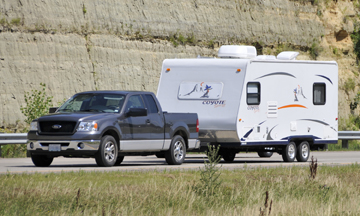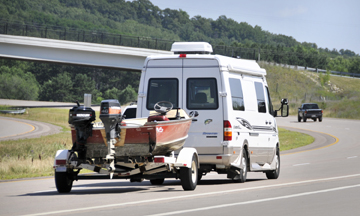Hitches and Towing 101
| CHAPTER CONTENTS | |
| 1. Introduction to Towing | 7. Brake Controls |
| 2. Towing Components | 8. Hitch Installation |
| 3. Types of Hitches | 9. Hooking Up |
| 4. Determining Tow Capacity | 10. Tow Bars/Dinghy Towing |
| 5. Selecting Your Hitch | 11. Towing Safety |
| 6. Wiring/Electrical | 12. Preparing Your Tow Vehicle |
Chapter 1 -
Introduction to Towing
Towing a trailer need not be a stressful driving situation, even though
several aspects of your normal driving experience may change. Your vehicle
becomes heavier, slower, and doesn't generally stop as well. It seems like other
drivers rush around you, won't let you change lanes, and worst of all, they'll
pull right in front of you and hit the brakes. It's no wonder that many drivers
are reluctant to tow a trailer. But with the right gear and the right
adjustments, towing can become almost as convenient and easy as normal
driving. You
should know what kind of trailer you plan to tow. You might find that you need
to tow a camping trailer, a utility trailer, a boat, a "dinghy" car behind your
RV, or a horse and livestock trailer. Your trailer may require a basic receiver hitch, or it could be a heavy-duty fifth wheel hitch or gooseneck
hitch design. The trailer may or may not come equipped with its own set
of brakes.
You
should know what kind of trailer you plan to tow. You might find that you need
to tow a camping trailer, a utility trailer, a boat, a "dinghy" car behind your
RV, or a horse and livestock trailer. Your trailer may require a basic receiver hitch, or it could be a heavy-duty fifth wheel hitch or gooseneck
hitch design. The trailer may or may not come equipped with its own set
of brakes.
Your towing needs are also dependent on the distance and road
conditions along your route. For example, if you plan to tow a small trailer
with motorcycles or ATVs to remote locations on unpaved roads, your needs are
quite different from the driver who plans to tow a large fifth-wheel camper on
Interstate freeways. And you might even have to consider alternating between
both of these scenarios, and accommodating bike racks or cargo
carriers.
Your tow vehicle may be a heavy or light-duty pickup truck, an
RV, an SUV or family van, or a standard passenger car. Each of these has
different characteristics and capabilities, and each may require different
equipment to tow safely and legally. Additionally, your vehicle may be set up
from the factory for towing, or you might need to install a hitch, wiring, or
other upgrades before you can tow.
When
you know these basic facts, you're ready to look up what you need. Whatever your
individual towing situation may be, this website provides detailed information
to help you match your vehicle to the right size trailer, select and install a
hitch and wiring, choose towing accessories, hook up correctly, and tow your
trailer successfully.
We'll start by defining the names and
concepts you're likely to encounter as you get your vehicle and trailer
together. You'll learn
- about the different types of trailer hitches and connections
- how to determine your vehicle's towing capacity
- how to upgrade your vehicle for better towing performance
- how to select the right hitch and ball
- how to wire up your vehicle and trailer
- how to install a trailer brake controller
- how to flat-tow a car or use a tow dolly.
- Finally, we'll cover some tips for safe and pleasant towing on the highway.
A picture is worth a thousand words, so in each article in this series we'll have diagrams, tables, and photos to illustrate how to choose and use the towing gear you need. Our goal is to provide you the resources you need to make towing your trailer a pleasant experience, so that you arrive at your destination relaxed and ready to enjoy the location or activity you wanted in the first place.
| Go to Chapter 2 >> |




